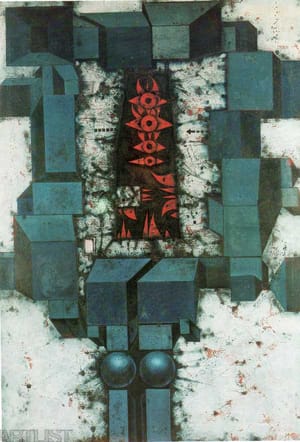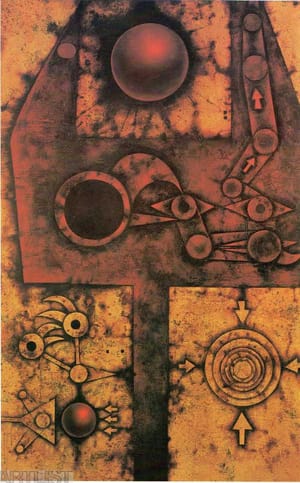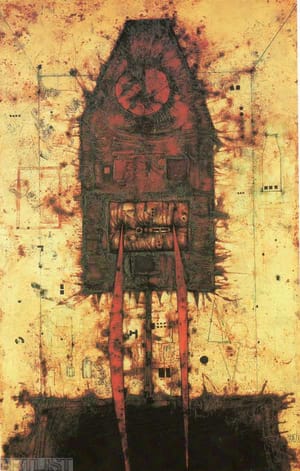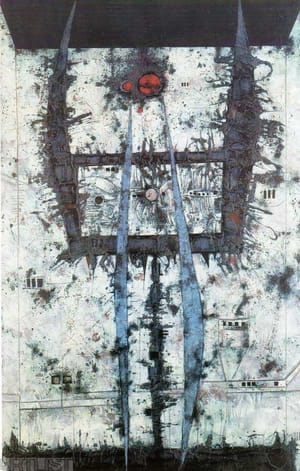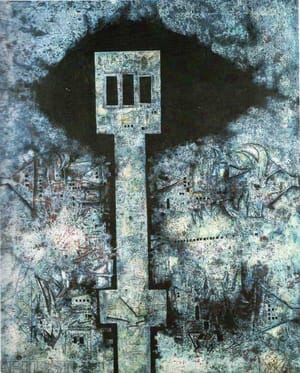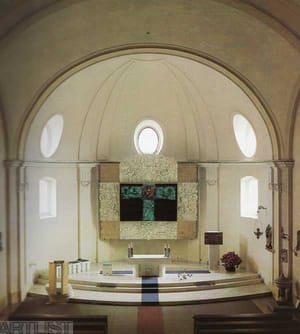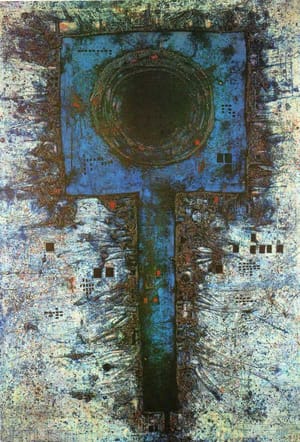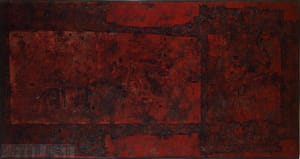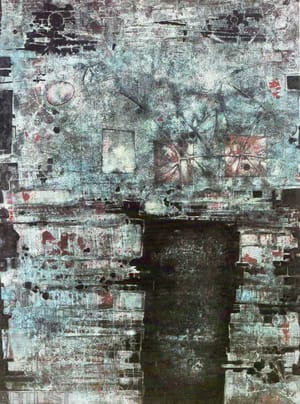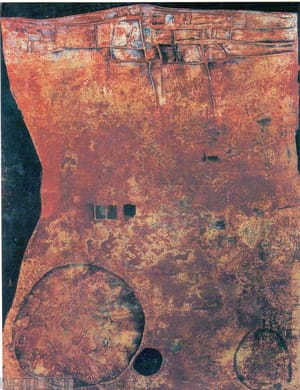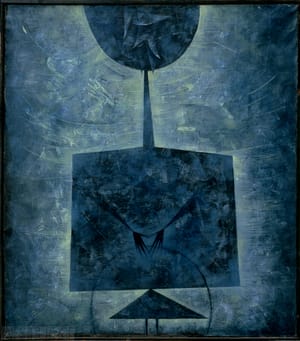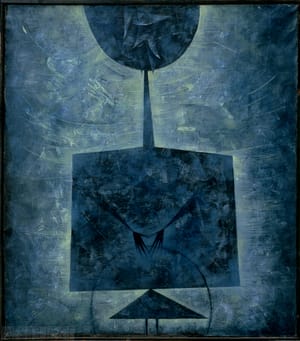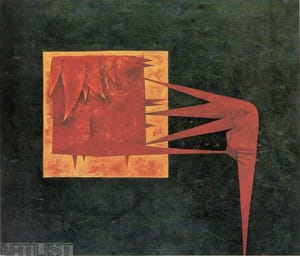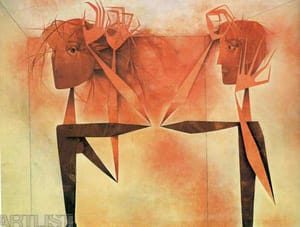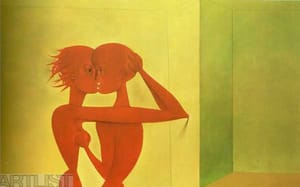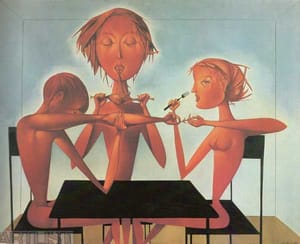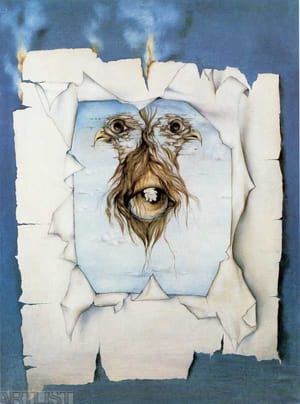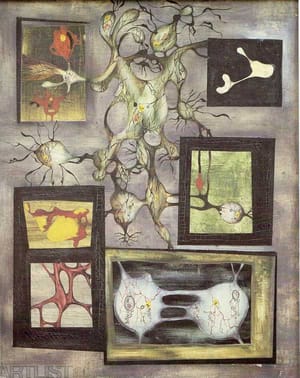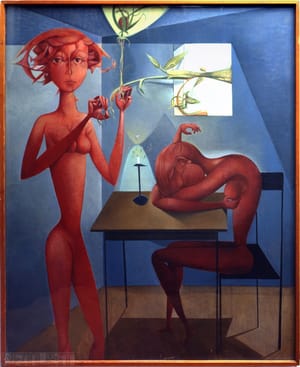- First Name
- Mikuláš
- Surname
- Medek
- Born
- 1926
- Birth place
- Prague
- Died
- 1974
- Keywords
- CSU Library
- ↳ Find in the catalogue
About artist
Mikuláš Medek was the grandson of the impressionist Antonín Slavíček, the son of General Rudolf Medek, and his brother was the well known journalist and writer for Voice of America Ivan Medek. After 1945, Medek began studying at the Academy of Fine Arts in Prague. However, after the communist coup d’état and as the son of a legionnaire and general in the army of the First Republic, in 1949 he was expelled as part of the purges. He worked as a labourer for Škodové závody in Smíchov, Prague, while on the side working as a graphic designer and restorer. He never gave up his art work, and worked with Karel Teige, for instance, whom he assisted in the publication of art anthologies. His painting, which he worked on without interruption and diligently, was strictly a private affair.
His uncompromising approach, both in his civilian life and in his work, brought him recognition and made him a kind of guru to the young generation on the unofficial art scene at the end of the 1950s. His name was closely linked with a circle of artists associated with the beginnings of Czech informel, which was exhibited at the legendary private exhibitions Confrontations I and Confrontations II. Medek was invited to participate, though in the end did not exhibit (though some literature mistakenly lists his name amongst the exhibitors). However, he was a kindred spirit both artistically and philosophically of the young generation and visited the exhibitions.
Medek created his first works while at AVU in 1945. At this time he was influenced by surrealism. “In Medek’s early works we see an interesting approach to the principles of European surrealism, something we could call surrealistic mannerism, i.e. a late, syncretic phase of a certain artistic opinion that uses a readymade, fully developed aesthetic and symbols in order to express completely new, personal worlds and to attain different objectives.” (František Šmejkal). The work of this time reveals traces of Miró, Klee, Dalí, Ernst, as well as Toyen (the cycle Onion World / Svět cibule, 1945-1947, Infantile Landscape / Infantilní krajina, 1947, Midday Smiles / Úsměvy poledne, 1949, etc.).
However, at the start of the 1950s Medek fell under the influence of existentialism. The figure begins to dominate in his paintings, becoming witness to Man’s disquieting, lacerating and hopeless situation. The existentialist concept of human existence suited him both in terms of the intellectual trends of the day and as a reaction to the intolerable situation of a person living under the repressive yoke of the communist regime. The figures (mainly female) in these paintings are mercilessly deformed and placed within an empty space, “so that they experience the dreadful drama of their brutal animalism, sadism, anxiety, ugliness, eternal solitariness and horror.” (František Šmejkal). Certain scenes of everyday life are made absurd (Large Meal/ Velké jídlo, 1954-56, The Kiss / Polibek, 1955). At the end of the 1950s, Medek’s figures are gradually stylised. Both they and the space around them are flattened out and lose their descriptive details. This represents an intermediate stage in the movement towards abstraction.
The first paintings of this new approach appeared in 1959 (e.g. Red Venus / Červená Venuše, 1959). Forms bearing only a slight resemblance to the human figure were created using a new painterly technique: as well as oil paints, Medek begins to use enamel. This enabled him to fill the surface of the canvas with thick sediments of paint that he subjects to further processing (incisions, scratches and cracks). After 1963, various features and symbols accumulate in Medek’s paintings, which become more dramatic (The Grim Reaper for 21,870 Delicate cm2 / Smrtka pro 21 870 křehkých cm2, 1964). The figure returns in a roundabout way, albeit very allusively. Motifs featuring screens, circular targets, funnels, rectangles, wheels and levers appear. Many of these paintings oscillate between a depiction of a highly stylised human figure and scenes of strange mechanisms that come alive in the form of enigmatic beings (Holy Gourmand / Svatý jedlík, 1966). Medek’s paintings became a complex mental construction of ambiguous symbolic systems, an artistic metaphor for the existence of Man, who finds himself in a tragic, grotesque situation and is thrown into an absurd world filled with pain and a bleak destiny.
During the normalisation period after 1970 Medek was again blacklisted. He was unable to exhibit or create works for public spaces, and it was forbidden to publish his writings. An important cycle of this time is entitled Mobile Graves / Pohyblivé hroby. The jagged torn materials of his previous work are confronted with structurally clearer forms of rectangles and balls (Large Mobile Grave / Velký pohyblivý hrob, 1973).
Medek’s paintings are a response to surrealist, existential and informel currents and the artistic trends of the 20th century. However, he reworked the surrealist tradition through irony, and while accepting the gestural concept of informel, through a laborious process of transformation he rids the image of its testimony as immediate record, the result being often very ornamental.
Mikuláš Medek died in 1974 at the age of 47 as a result of complications associated with diabetes.
In 2002, the Rudolfinum Gallery organised a retrospective of Medek’s work. A symposium was also held that examined the relevance of his work to the present day. Several young art theorists spoke at the symposium who had not known the artist. Their contributions were often critical in spirit, seemingly aiming to demythify the artist and his work and question his standing within a global context. Their contributions took issue with the heroisation of Medek as a famous outsider stigmatised by the times he lived in, which he in turn also stigmatised.
- Author of the annotation
- Ivona Raimanová
CV
1949 ze školy vyloučen a pracuje jako soustružník ve Škodovce v Praze Smíchově
1946-1949 Academy of Applied Arts, Professor František Muzika and František Tichý
1945-1946 Academy of Fine Arts, Prague,Karel Minář, Vlastimil Rada
1942-1944 Státní School of Graphic Arts, Prague, Karel Müller
Awards:
1969 státní cena za cyklus obrazů "Projektanti věží"
1966 výroční cena nakladatelství Blok v Brně za ilustrace k "Rukám" Otokara Březiny
1964 1. cena v soutěži na výzdobu prostoru nové letištní budovy v Praze-Ruzyni
Exhibitions
- Solo exhibitions
-
2002
Mikuláš Medek, Galerie Rudolfinum, Praha 1
1991
Obrazy: Výběr z tvorby, Kabinet grafiky, Olomouc
1990
Souborné malířské dílo, Dům umění města Brna, Brno
Malířské dílo 1942-1974, Městská knihovna, Praha
Obrazy: Výběr z tvorby, Zámek Hluboká nad Vltavou, Hluboká nad Vltavou
Obrazy: Výběr z tvorby, Oblastní galerie Vysočiny v Jihlavě, Jihlava
1988
Vybrané obrazy z let 1944/1974, Galerie výtvarného umění, Roudnice
nad Labem
1976
Mikuláš Medek 1926-1974, Museum Bochum, Bochum
1975
Výstava obrazů, Ateliér Mikuláše Medka, Praha
1969
Kresby a ilustrace, Malá galerie Československého spisovatele, Praha
Projektanti věží, Galerie Václava Špály, Praha
Obrazy 1944-1969, Krajská galerie, Hradec Králové
1966
Mikuláš Medek, Jednotný závodní klub ROH, Ústí nad Orlicí
1966
Dvacet dosud nevystavených obrazů z let 1960-65, Oblastní galerie
v Liberci, Liberec
1965
Výběr obrazů z let 1947 - 65, Galerie Nová síň, Praha
1963
Oblastní vlastivědné museum Teplice, s J. Koblasou (kat. Fr. Šmejkal)
- Group exhibitions not included in ARTLIST.
-
2010
Roky ve dnech. České umění 1945-1957, Městská knihovna, Praha
2009
Gegen jede Vernunft: Surrealismus Paris - Prag, Wilhelm-Hack-Museum, Ludwigshafen am Rhein
2007
Mikuláš a Emila Medkovi: Souvislosti, Severočeská galerie výtvarného umění v
Litoměřicích
2004
Ejhle světlo / Look Light, Jízdárna Pražského hradu, Praha
Šedesátá / The sixties ze sbírky Galerie Zlatá husa v Praze, Dům umění města Brna, Brno
Blízká vzdálenost / Közeli távolság / Proximate Distance, Szent István Király Múzeum, Székesfehérvár
2003
Umění je abstrakce. Česká vizuální kultura 60. let, Jízdárna Pražského hradu, Praha
Umění je abstrakce. Česká vizuální kultura 60. let, Salon, Kabinet, Olomouc
2002
Anima & Animus (manželské páry v generaci 60. let), Galerie Zlatá husa, Praha
2001
Jiří Kolář sběratel / Jiří Kolář the Collector, Veletržní palác, Praha
1999
Mikuláš Medek: Obrazy, Jan Koblasa: Plastiky, Hrad Bítov, Bítov
Umění zrychleného času. Česká výtvarná scéna 1958 - 1968, Praha
Aspekte / Positionen. 50 Jahre Kunst aus Mitteleuropa 1949-1999, Vídeň
1998
Podoby fantaskna v českém výtvarném umění 20. století, Alšova jihočeská galerie v Hluboké nad Vltavou, Hluboká nad Vltavou
1997
Novozákonní motivy v Českém umění 20. století, Galerie umění Karlovy Vary, Karlovy Vary
Aspekte imaginativer Kunst im 20. Jahrhundert: Profil und Perspektiven einer Sammlung, Museum Bochum, Bochum
Umění zastaveného času / Art when time stood still, Česká výtvarná scéna 1969-1985, Brno
Umění zastaveného času / Art when time stood still, Česká výtvarná scéna 1969-1985, Státní galerie výtvarného umění v Chebu
Aspekte imaginativer Kunst im 20. Jahrhundert: Profil und Perspektiven einer Sammlung, Kunstverein Gütersloh, Gütersloh
Surrealistická obraznost a kresba, Palác Kinských, Praha
České imaginativní umění, Galerie Rudolfinum, Praha
1996
V prostoru 20. století. České umění ze sbírky Galerie hlavního města Prahy, Městská knihovna, Praha
Eine Promenade der Romantiker, Stadtmuseum Göhre, Jena
Novozákonní motivy v Českém umění 20. století, Galerie moderního umění v Roudnici nad Labem, Roudnice nad Labem
Umění zastaveného času / Art when time stood still, Česká výtvarná scéna 1969-1985, Praha
Český surrealismus 1929-1953, Městská knihovna, Praha
1994
Ohniska znovuzrození, Městská knihovna, Praha
1993
Záznam nejrozmanitějších faktorů… České malířství 2. poloviny 20. století ze sbírek státních galerií, Jízdárna Pražského hradu, Praha
1991
Český informel. Průkopníci abstrakce z let 1957-1964, Praha,
1990
Výtvarné tendence, Středočeská galerie, Praha
Polymorphie: Kunst als subversives Element Tschechoslowakei 1939-1990,
Martin-Gropius-Bau, Berlín
1989
Z nových zisků Národní galerie v Praze (1987 - 1988), Národní galerie v Praze, Praha
1987
Grotesknost v českém výtvarném umění 20. století, Staroměstská radnice, Praha
1984
Česká kresba 20. století ze sbírek Alšovy jihočeské galerie, Alšova jihočeská galerie v Hluboké nad Vltavou, Hluboká nad Vltavou
1983
20 let Galerie hlavního města Prahy, Staroměstská radnice, Praha
Das Prinzip Hoffnung. Aspekte der Utopie in der Kunst und Kultur des 20. Jahrhunderts, Museum Bochum, Bochum
1974
Osteuropäische Kunst aus der Sammlung des Museum Bochum, Museum Bochum, Bochum
1971
45 zeitgenössische künstler aus der Tschechoslowakei. Malerei, Plastik, Grafik,
Glasobjekte, Baukunst, Kolín nad Rýnem (Köln)
1969
Tschechische Malerei des 20. Jahrhunderts, Ausstellungsräume Berlin 12, Berlín
L´art tcheque actuel, Renault Champs - Élysées, Paříž
Phases, Oblastní galerie Vysočiny v Jihlavě, Jihlava
1968
Nové věci, Galerie Václava Špály, Praha
Počátky generace, Galerie Václava Špály, Praha
50 let československého malířství 1918 - 1968, Praha
1967
České umění XX. století ze sbírek Středočeské galerie, Dům umění města Brna, Brno
Moderne Kunst aus Prag, Caroline-Mathilde-Räume im Celler Schloß, Celle
Mostra d´arte contemporanea cecoslovacca, Castello del Valentino, Turín
Moderne Kunst aus Prag, Wilhelm-Morgner-Haus, Soest
Moderne Kunst aus Prag, Kunsthalle zu Kiel, Kiel
Fantasijní aspekty současného českého umění, Oblastní galerie Vysočiny v Jihlavě, Jihlava
Fantasijní aspekty současného českého umění, Galerie Václava Špály, Praha
Jeden okruh volby: Obrazy, sochy, objekty, grafika, kresby 1964-1967, Okresní muzeum, Písek
1966
Nové cesty. Přehlídka současné avantgardy, Dům umění, Gottwaldov (Zlín)
Jarní výstava 1966, Mánes, Praha
Tschechoslowakische Kunst der Gegenwart, Akademie der Künste, Berlín
Arte actual Checoslovaco, Museo de Arte Moderno, Mexico City
Symboly obludností (Tematická studijní výstava UDS), Galerie d, Praha
Aktuální tendence českého umění. Obrazy, sochy, grafika, Galerie Československý spisovatel, Praha
Nouvelle génération tchécoslovaque, Galerie Maya, Brusel
1965
Tschechoslowakische Kunst heute: Profile V, Städtische Kunstgalerie, Bochum
Jeune avant-garde tchécoslovaque, Galerie Lambert, Paříž
La transfiguration de l´art tcfhéque: Peinture - sculpture - verre - collages, Palais de Congres, Liege
1964
Imaginativní malířství 1930 - 1950, Alšova jihočeská galerie v Hluboké nad Vltavou, Hluboká nad Vltavou
Výstava D, Galerie Nová síň, Praha
1963
Umění 1900-1963, Alšova jihočeská galerie v Hluboké nad Vltavou, Hluboká nad Vltavou
Jan Koblasa, Mikuláš Medek: Výstava obrazů z let 1959 - 1963, Vlastivědné muzeum, Gottwaldova síň, Teplice
Rychnov 1963, Zámek Rychnov nad Kněžnou, Rychnov nad Kněžnou
1962
Argumenty 1962, Galeria Sztuki Nowoczesnej, Varšava
1958
1. výstava současných českých výtvarníků, Filozoficko-historická fakulta, Praha
- Collections
-
Národní galerie v Praze
Galerie hlavního města Prahy
Galerie středočeského kraje, Kutná Hora
Moravská galerie, Brno
Alšova jihočeská galerie, Hluboká nad Vltavou
Galerie moderního umění Hradec Králové
Galerie výtvarného umění Cheb
Oblastní galerie Vysočiny, Jihlava
Galerie umění Karlovy Vary
Oblastní galerie Liberec
Severočeská galerie výtvarného umění Litoměřice
Galerie Benedikta Rejta, Louny
Muzeum umění Olomouc
Galerie výtvarného umění Ostrava
Východočeská galerie, Pardubice
Západočeská galerie, Plzeň
Galerie moderního umění, Roudnice nad Labem
Krajská galerie výtvarného umění, Zlín
Museum Boymans van Beuningen, Rotterdam
Museum of Modern Art, Sydney
Stadtische Kunstgalerie, Bochum
Slovenská národní galérie Bratislava
Muzej na sovremena umetnost, Skopje
private collections in ČR, SR, Belgii, Francii, Itálii, Německu, Polsku, Rakousku, Švédsku, Švýcarsku, USA, Velké Británii
- Other realisations
Realisations in public spaces and architecture
various pieces for Czech Airlines
1970
New York
1969
Praha Ruzyně
1964
Paříž
1963
Damašek
1963
Košice
altar paintings:
1971
14 obrazů křížové cesty pro kostel v Senetářově
1970
oltářní obraz pro kapli v Kotvrdovicích
1963
oltářní obraz pro farní kostel v Jedovnicích
Monography
- Monography
2002 Mikuláš Medek, Gema Art, Praha
1970 Mráz Bohumír, Mikuláš Medek, Obelisk, Praha
1963 Jan Koblasa, Mikuláš Medek: Výstava obrazů z let 1959 – 1963, Svaz československých výtvarných umělců, Ústí nad Labem
Další monografie:
2010 Klimešová Marie , Roky ve dnech (České umění 1945 - 1957), Galerie hlavního města Prahy
2003 Zdeněk Primus, Umění je abstrakce (Česká vizuální kultura 60. let), Kant, Praha
1997 Nešlehová Mahulena , Poselství jiného výrazu (Pojetí informelu v českém umění 50. a první poloviny 60. let), Artefact, Praha
1994 Chalupecký Jindřich , Nové umění v Čechách, Nakladatelství a vydavatelství H&H, s.r.o., Jinočany
1994 Ohniska znovuzrození (České umění 1956 - 1963), GHMP
1991 Český informel (Průkopníci abstrakce z let 1957 - 1964)
1991 Brabec Jiří , Gruša Jiří , Hájek Igor , Kabeš Petr , Lopatka Jan , Slovník zakázaných autorů 1948-1980, Státní pedagogické nakladatelství, Praha
1987 Grotesknost v českém výtvarném umění 20. století, GHMP
1969 Effenberger Vratislav , Výtvarné projevy surrealismu, Odeon, nakladatelství krásné literatury a umění, n.p., Praha
1967 František Šmejkal, Fantasijní aspekty současného českého umění, Oblastní galerie Vysočiny, Jihlava
